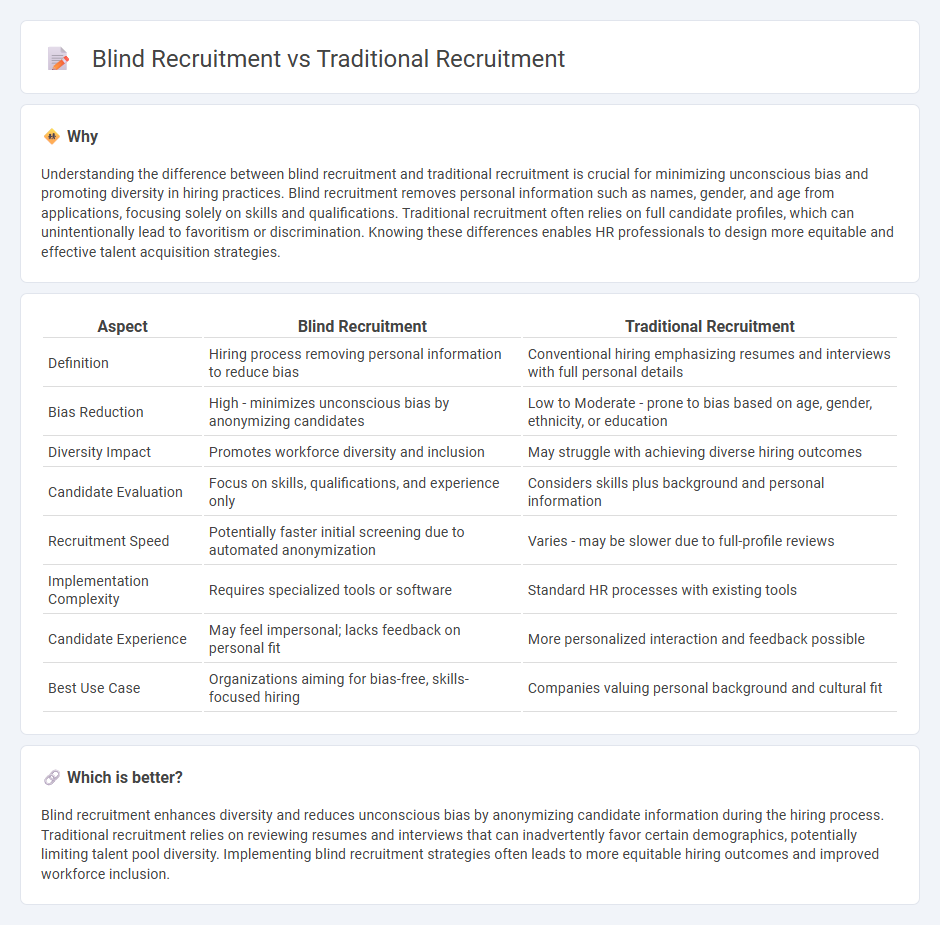
Blind recruitment enhances fairness by removing identifiable candidate information, reducing bias related to gender, ethnicity, or age, leading to diverse and inclusive hiring outcomes. Traditional recruitment often depends on resumes and interviews where unconscious biases can influence decision-making, potentially limiting talent pool diversity. Explore deeper insights on how blind recruitment can transform your hiring process for equitable talent acquisition.
Why it is important
Understanding the difference between blind recruitment and traditional recruitment is crucial for minimizing unconscious bias and promoting diversity in hiring practices. Blind recruitment removes personal information such as names, gender, and age from applications, focusing solely on skills and qualifications. Traditional recruitment often relies on full candidate profiles, which can unintentionally lead to favoritism or discrimination. Knowing these differences enables HR professionals to design more equitable and effective talent acquisition strategies.
Comparison Table
| Aspect | Blind Recruitment | Traditional Recruitment |
|---|---|---|
| Definition | Hiring process removing personal information to reduce bias | Conventional hiring emphasizing resumes and interviews with full personal details |
| Bias Reduction | High - minimizes unconscious bias by anonymizing candidates | Low to Moderate - prone to bias based on age, gender, ethnicity, or education |
| Diversity Impact | Promotes workforce diversity and inclusion | May struggle with achieving diverse hiring outcomes |
| Candidate Evaluation | Focus on skills, qualifications, and experience only | Considers skills plus background and personal information |
| Recruitment Speed | Potentially faster initial screening due to automated anonymization | Varies - may be slower due to full-profile reviews |
| Implementation Complexity | Requires specialized tools or software | Standard HR processes with existing tools |
| Candidate Experience | May feel impersonal; lacks feedback on personal fit | More personalized interaction and feedback possible |
| Best Use Case | Organizations aiming for bias-free, skills-focused hiring | Companies valuing personal background and cultural fit |
Which is better?
Blind recruitment enhances diversity and reduces unconscious bias by anonymizing candidate information during the hiring process. Traditional recruitment relies on reviewing resumes and interviews that can inadvertently favor certain demographics, potentially limiting talent pool diversity. Implementing blind recruitment strategies often leads to more equitable hiring outcomes and improved workforce inclusion.
Connection
Blind recruitment and traditional recruitment are connected through their shared goal of identifying the best candidates for job positions while differing in approach and bias reduction. Traditional recruitment relies heavily on resumes and interviews, which can introduce unconscious biases related to gender, ethnicity, or educational background. Blind recruitment eliminates these biases by anonymizing candidate information, focusing solely on skills and qualifications to enhance diversity and fairness in the hiring process.
Key Terms
Bias
Traditional recruitment often allows unconscious biases to influence hiring decisions through cues like names, gender, and educational background, which can limit diversity and inclusion. Blind recruitment removes identifying information from applications to reduce bias, promoting fairer assessments based solely on skills and qualifications. Explore how implementing blind recruitment strategies can enhance workplace diversity and equity.
Anonymity
Traditional recruitment often relies on reviewing resumes and interviews where personal information such as name, age, and gender can influence hiring decisions, potentially introducing unconscious bias. Blind recruitment emphasizes anonymity by removing identifying details, promoting fairer candidate evaluation based solely on skills and qualifications. Discover how adopting blind recruitment can transform your hiring process and foster diversity.
Candidate Screening
Traditional recruitment relies heavily on resumes, references, and interviews to evaluate candidates, often influenced by biases related to gender, age, or ethnicity during the screening process. Blind recruitment removes identifying information such as names and backgrounds, enhancing objectivity by focusing solely on skills and qualifications during candidate screening. Explore how blind recruitment can transform your hiring process for unbiased and effective candidate selection.
Source and External Links
Traditional vs Modern Recruitment: Which One is Best? - This webpage discusses traditional recruitment methods, including job advertisements, employee referrals, and in-person interviews, highlighting their strengths and weaknesses.
Traditional vs Modern Recruitment: Which is Best? - The article compares traditional recruitment methods, such as personal connections and established processes, with modern methods, focusing on their advantages and disadvantages.
Using Traditional & Non-Traditional Sources of Recruitment - This resource explores traditional recruitment sources like internal postings, employee referrals, and job fairs, emphasizing their reliability and effectiveness.
 dowidth.com
dowidth.com